Angela Rae Harris's Blog, page 27
September 22, 2025
EDITORIAL: ‘Crowded’ prisons = safer Colorado
Let’s welcome news reported by The Gazette this week that Colorado’s prison population is on the rise, with more lawbreakers reportedly behind bars for parole violations.
That’s encouraging in a state that has weathered an epic crime wave in recent years, often enough at the hands of parolees. The surge in our prison population reflects a renewed commitment by law enforcement — including parole officers, who police parolees and try to keep them on track — to prioritize public safety.
Misguided, out-of-touch advocates of the “justice reform” movement already are wringing their hands over the thought of convicts out on parole being sent back to the slammer for what the justice reformers insist are mere “technical” violations of parole conditions.
“We are sending people back to prison who are not dangerous,” claimed Boulder Democratic state Sen. Judy Amabile, a prime mover of soft-on-crime legislation at the State Capitol. “There’s a wide variety of technical parole violations, but sometimes they can be really inconsequential things, and people still end up back in DOC.”
Oh, the poor dears!
In reality, of course, parole is a privilege, granted conditionally in exchange for shortening an original prison sentence. And those conditions typically include restrictions put in place to help keep the convict out of trouble and give him or her a better chance of staying on the right side of the law en route to reform. Parolees may be ordered, for example, to stay away from former criminal associates. Or, they may be barred from drinking alcohol. Those are not punishments; they are an acknowledgement of a parolee’s weaknesses — indeed, many are substance abusers — that can pull them back into a life of crime.
Ask anyone in law enforcement; parole violations aren’t the “inconsequential things” Amabile thinks they are. They all too often are an urgent warning a parolee is about relapse into lawbreaking.
Which is why swiftly returning them to prison makes society safer. And it’s why any crackdown on parole violations is overdue.
But that good news comes with some troubling news. As noted in The Gazette’s report, the state’s rising prison population now has triggered a 2018 law enacted to curb prison crowding. Since the vacancy rate at the state’s correctional facilities has been under 3% for at least 30 consecutive days, a protracted series of steps will kick in under that law that could lead at some point to granting more parole — reversing the benefits of the crackdown.
Our offender-friendly legislature made matters worse this year when it eliminated about 300 beds from corrections’ facilities in a bid to rein in this year’s budget deficit — which lawmakers’ had caused with their runaway spending. Meaning, they balanced their busted budged in part by sacrificing public safety.
There is a direct correlation between incarceration and crime. As Colorado’s Common Sense Institute found in a groundbreaking 2021 analysis, between 2008 and 2021, Colorado’s prison population declined 23% while the total number of annual crimes increased 47%.
Which means the only responsible solution for prison crowding is to put public safety first — and add as much prison space as needed to achieve that end.
What Robert Redford meant to Westerners | Vince Bzdek
In Sundance, Utah, where Robert Redford spent most of his time off screen, he was just known as “The Bob.”
“Have you seen The Bob today?” “The Bob was just down at the river.” “Here comes The Bob.” Staff said it in a way you might speak of royalty, like “Here comes The King.”
For those of us who live in the Rocky Mountain West, The Bob was more than a movie star, he was a kind of royalty, the intellectual Cowboy King of the West. Redford, who passed away at the age of 89 last week, was the prototype for us of the ideal New Westerner. He didn’t just play the West on screen; he lived it daily, embodying its landscapes, struggles, and enduring cultural power.
Redford’s personal choices—to live in the mountains, to dedicate himself to conservation, to buck authority and promote independent voices in film—blur the line between Robert Redford the man and Robert Redford the Western icon.
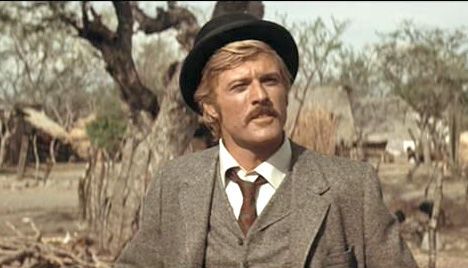 Robert Redford shot both “Butch Cassidy and the Sundance Kid” in Colorado in 1969 and “Our Souls at Night” wth Jane Fonda in 2016.
Robert Redford shot both “Butch Cassidy and the Sundance Kid” in Colorado in 1969 and “Our Souls at Night” wth Jane Fonda in 2016.From an early age, he felt a pull toward independence and open landscapes. He has often described himself as a misfit in conventional settings, restless for wider horizons—an attitude deeply aligned with Western archetypes of wanderers and seekers.
“I think I just have an outlaw sensibility,” he said in an 2022 interview with Bob Woodward, the crusading journalist Redford portrayed in “All the President’s Men.” “I’ve always been independent. I’ve always wanted to stay free.”
After a brief stint at the University of Colorado on a baseball scholarship, Redford hitchhiked through the American West, absorbing the landscapes and cultures that would later define his artistic vision. These early travels instilled in him the sense of freedom, risk-taking, and respect for the land that echo throughout his career and activism.
Rooting Himself in Utah
Unlike most Hollywood stars who anchored their lives in Los Angeles or New York, Redford chose the mountains of Utah as his true home. In the early 1960s, he bought land at the base of Mount Timpanogos and built a retreat there. His decision was less about escape than about alignment with values: solitude, creativity, and stewardship of nature.
“I wanted to a find a place that would be the last outpost of development and this seemed to be it,” he said in an interview for CBS Sunday Morning. “So I bought two acres of land in 1961 for 500 bucks. From a sheepherder.”
Think of that: Just as his career was taking off as one of Hollywood’s most bankable movie stars, he decamped from the Yellow Brick Road for remotest Mormon Utah.
He built his own house and “that’s how it all started,” he said. Eventually he bought 6,000 mountain acres and named them after his first big movie role, the Sundance Kid, launching the Sundance Institute and film festival that would nurture the best and most iconoclastic independent filmmakers outside of Hollywood. He managed to escape the traps of success in Utah, grounding himself in something realer and leaving a legacy much greater than his own fame.
Life as a Western Archetype
His movie choices mirrored his Western orientation, so much so he became the guy we Westerners expected to represent all that was good about the West on the screen.
 Festivalgoers walk past a poster of Robert Redford, far left, and Paul Newman in the film “Butch Cassidy and the Sundance Kid” during the Sundance Film Festival in Park City, Utah, Friday, Jan. 22, 2010. Redford is the president of the Sundance Film Institute. (AP Photo/Chris Pizzello)
Festivalgoers walk past a poster of Robert Redford, far left, and Paul Newman in the film “Butch Cassidy and the Sundance Kid” during the Sundance Film Festival in Park City, Utah, Friday, Jan. 22, 2010. Redford is the president of the Sundance Film Institute. (AP Photo/Chris Pizzello)In 1969, Redford starred in “Butch Cassidy and the Sundance Kid” about the infamous Wyoming outlaws, and then three years later, starred in “Jeremiah Johnson.” That hyperrealistic American Western was based partly on the life of the legendary mountain man John Jeremiah Johnson, a.k.a Liver-Eating Johnson, and filmed in the Utah mountains near his home.
He also starred in “The Horse Whisperer,” “Electric Horseman,” “Tell Them Willie Boy is Here,” and directed and narrated the Montana classic, “A River Runs Through It,” all Westerns of a sort. He also produced an eight-episode TV documentary, “The American West.”
With Redford, it was more a case of art imitating life than the more common life imitating art.
Like the Sundance Kid or Jeremiah Johnson, he lived on the edge of convention, forging his own path, often against the grain of mainstream Hollywood. His square jaw and rugged good looks, often compared to the cowboy ideal, reinforced his status as a symbolic Westerner. Yet unlike those mythic gunslingers, he redefined the Western archetype
Though he looked like a golden boy, he thought like a subversive. I think that tension kept us coming back for more, and during the counterculture days of the 70s, rang truer than traditional heroes for most of us. He played hero roles, but his heroes were often flawed and vulnerable, white knights well aware of how easy it is for a man to tarnish. The Sundance Kid dies in a blaze of gunfire. “The Candidate” ends his upset campaign victory, a victory of style over substance, by asking “What do we do now?” The champion skier in “Downhill Racer” isn’t a triumphant underdog, but rather a sports fanatic who makes no effort to mask his arrogance and understand himself beyond his image.
“He has a passion for telling stories that reflect the strengths and the vulnerabilities of the American spirit,” Barbara Streisand said In her tribute to Redford when he won a lifetime achievement Oscar, “our struggle to achieve what is highest in our nature, and though we don’t always succeed, Robert Redford films make certain that we celebrate the effort “
Streisand, his costar in “The Way We were,” called him our “intellectual cowboy.”
But I’ll be forever most thankful for how he appreciated and elevated the Rocky Mountain West in America’s imagination. He took our homeground and sprinkled a bit of stardust on it, making it even more magical than it already was.
In Jeremiah Johnson, which most of all celebrates the union of man and mountain, a loquacious character named Del Gue rides off into the snowscape at the end summing up what I’d guess is Redford’s truest take on the West he called home:
“These here is God’s finest scupturings!” Del Gue says of the Rockies. “And there ain’t no laws for the brave ones! And there ain’t no asylums for the crazy ones! And there ain’t no churches, except for this right here! And there ain’t no priests excepting the birds. By God, I are a mountain man, and I’ll live ’til an arrow or a bullet finds me. And then I’ll leave my bones on this great map of the magnificent…
“The Rocky Mountains,” he concludes, “is the marrow of the world.”
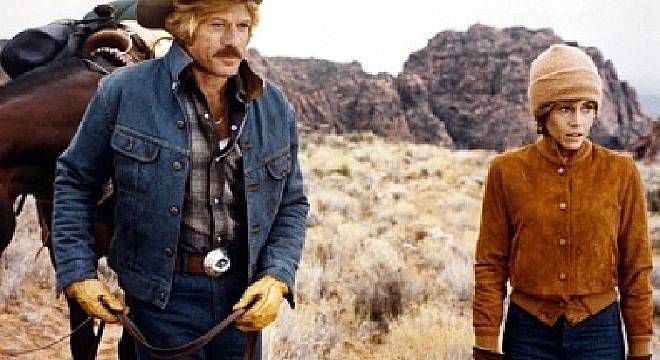 The 1979 film “The Electric Horseman” was the last film Robert Redford and Jane Fonda did together before teaming up again in 2016 for “Our Souls at Night,” an adaptation of the late Colorado author Kent Haruf’s novel and filmed in Colorado Springs.
The 1979 film “The Electric Horseman” was the last film Robert Redford and Jane Fonda did together before teaming up again in 2016 for “Our Souls at Night,” an adaptation of the late Colorado author Kent Haruf’s novel and filmed in Colorado Springs.
CU Buffs opponent lookahead: Unbeaten No. 25 BYU comes to Boulder for difficult Big 12 home opener
The Alamo Bowl rematch has arrived.
We all know what is going to happen in the leadup. There is going to be a lot of praise for the team on the other side, with both Deion Sanders and Kalani Sitake having an immense amount of respect for the other.
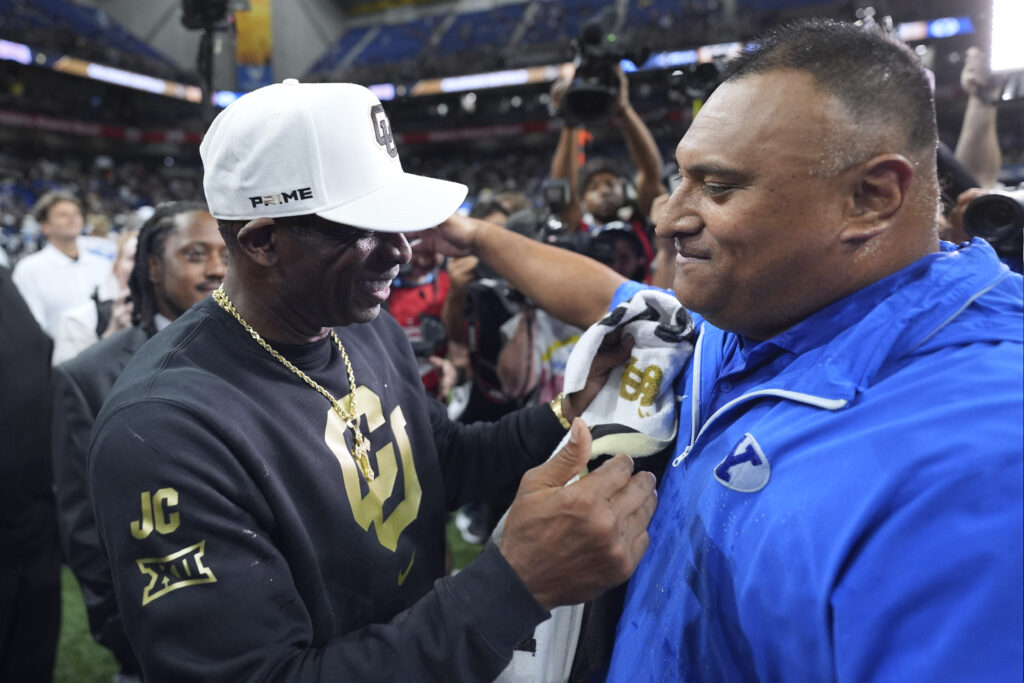 Colorado head coach Deion Sanders, left, and BYU head coach Kalani Sitake, right, meet at midfield following BYU’s win in the Alamo Bowl NCAA college football game, Saturday, Dec. 28, 2024, in San Antonio. (AP Photo/Eric Gay)
Colorado head coach Deion Sanders, left, and BYU head coach Kalani Sitake, right, meet at midfield following BYU’s win in the Alamo Bowl NCAA college football game, Saturday, Dec. 28, 2024, in San Antonio. (AP Photo/Eric Gay)But when the ball kicks off close to 8:30 p.m. on Saturday night in Boulder, both Colorado (2-2, 0-1 Big 12) and No. 25 BYU (3-0) will be after a crucial win that may determine which team heads into October as a Big 12 contender.
The Buffaloes got back to their winning ways last week with a solid showing against Wyoming, but they’re already behind the eight ball after losing on the road at Houston in their Big 12 opener, while the Cougars cruised through nonconference play without being tested.
Still, the majority of the BYU team that beat CU 36-14 in the Alamo Bowl last December is back and eager to prove a gap remains between the two programs.
Here’s what to expect from the Cougars:
Last time out
BYU left Provo for the first time in 2025 this past weekend and came back still having yet to face any real adversity.
Although the Cougars didn’t score an offensive touchdown until midway through the third quarter, their 34-13 win over East Carolina was relatively comfortable.
 BYU running back LJ Martin (4) runs the ball with East Carolina’s Teagan Wilk (3) in pursuit during the first half of an NCAA college football game in Greenville, N.C., Saturday, Sept. 20, 2025. (AP Photo/Karl DeBlaker)
BYU running back LJ Martin (4) runs the ball with East Carolina’s Teagan Wilk (3) in pursuit during the first half of an NCAA college football game in Greenville, N.C., Saturday, Sept. 20, 2025. (AP Photo/Karl DeBlaker)The BYU defense was the unit that built that lead by a pair of interceptions by Evan Johnson, one denying ECU a touchdown and another scoring one for the Cougars as a pick-6, defined the first half.
In the second half, the offense finally saw the reward after wearing down the Pirates defense on the ground as LJ Martin finished with over 100 rushing yards and a touchdown, while quarterback Bear Bachmeier got a touchdown on the ground and through the air to seal the win in the fourth quarter.
On offense
From the Alamo Bowl to now, not much looks different about the BYU offense — except under center.
After spending the spring at Stanford, Bachmeier arrived in Provo in the summer and won a heated quarterback battle after returning starter Jake Retzlaff decided to transfer while facing a looming suspension for violation of the university’s honor code. That opened the door for a true freshman wearing No. 47 to lead a BYU team with expectations to make the Big 12 championship game after coming up just short last season.
Through three games, Bachmeier has looked the part. He’s completed two-thirds of his passes for 518 yards and four touchdowns with no interceptions. But the majority of his job has been handing the ball off to Martin, the Big 12 leader in rushing yards per game and the head of the top rushing offense in the conference.
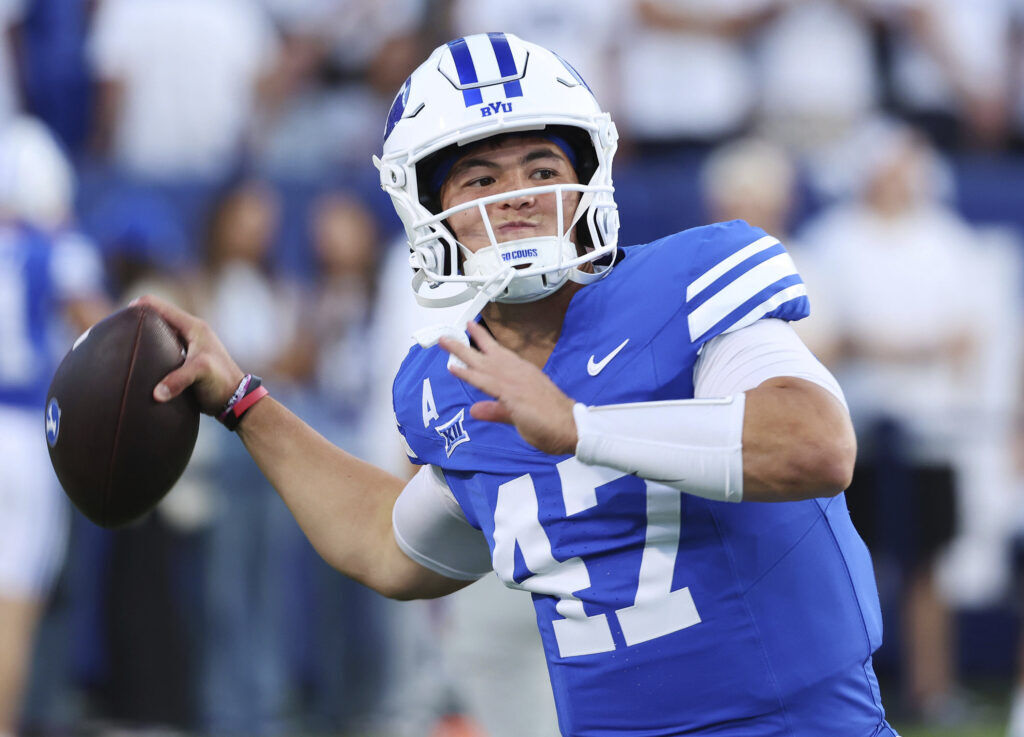 BYU quarterback Bear Bachmeier warms up against Stanford during pregame of an NCAA college football game on Saturday, Sept. 6, 2025, in Provo, Utah. (AP Photo/Jeffrey D. Allred)
BYU quarterback Bear Bachmeier warms up against Stanford during pregame of an NCAA college football game on Saturday, Sept. 6, 2025, in Provo, Utah. (AP Photo/Jeffrey D. Allred)After ending the season with 88 yards and two touchdowns against the Buffs in San Antonio, Martin has rattled off three straight 100-yard games to go with one touchdown and a yards per carry average of nearly nine.
The Cougars don’t run the ball out of necessity, though. They’ve got real downfield weapons in the passing game, too, most notably wide receiver Chase Roberts, an all-conference caliber who leads the team with 11 catches for 185 yards and a touchdown.
On defense
The No. 1 defense in the Big 12 is what the CU offense will face this Saturday night.
Granted, the competition hasn’t been great, but BYU has dominated games with a standout defense through three games, allowing a conference-best 5.3 points and 205.3 yards per game. The Cougars defense has scored as many touchdowns (1) as it’s allowed.
 BYU’s Evan Johnson (0) runs the ball away from East Carolina offensive lineman Jimarion McCrimon (62) after his interception during the first half of an NCAA college football game in Greenville, N.C., Saturday, Sept. 20, 2025. (AP Photo/Karl DeBlaker)
BYU’s Evan Johnson (0) runs the ball away from East Carolina offensive lineman Jimarion McCrimon (62) after his interception during the first half of an NCAA college football game in Greenville, N.C., Saturday, Sept. 20, 2025. (AP Photo/Karl DeBlaker)They’re deep and talented at all three levels, led by Logan Lutui and Jack Kelly up front, Isaiah Glasker at linebacker and Evan Johnson in the secondary.
After winning the starting quarterback job back with an impressive showing against Wyoming, Buffs quarterback Kaidon Salter will have his hands full this week.
The BYU Cougars file
Record: 3-0
Head coach: Kalani Sitake (10th season, 75-43 record)
Offensive coordinator: Aaron Roderick (8th season at BYU, 5th as OC)
Defensive coordinator: Jay Hill (4th season)
Names to know: QB Bear Bachmeier, RB LJ Martin, WR Chase Roberts, TE Carsen Ryan, OL Weylin Lapuaho, LB Isaiah Glasker, DE Logan Lutui, EDGE Jack Kelly, DB Evan Johnson, K Will Ferrin
Betting line: Colorado +6.5 (ESPN Bet)
Aurora lawmakers approve fees for parents of kids on dirt bikes, defendants with interpreters who fail to appear
Aurora lawmakers added a new fee and increased another in Monday night’s meeting, addressing kids on dirt bikes and failure to appear for people who need interpreters in court, respectively.
The council unanimously passed an ordinance that charges $250 to parents and guardians of minors caught riding dirt bikes in the city.
Councilmember Francoise Bergan sponsored the ordinance, which adds a level of enforcement to a city code that bans “off highway vehicles.”
Per the new ordinance, parents will be charged if their children are found riding vehicles that are not street legal in Aurora.
The idea behind the ordinance is to give police the ability to enforce city code when it comes to minors, who would previously just get a warning and no further punishment for riding non-street legal vehicles.
“This is all about safety,” Bergan said. “It’s a dangerous situation to have young kids out there in the roads with trucks and vehicles, so we want to prevent any kinds of accidents.”
There has been an increase in accidents and injuries to minors due to reckless dirt bike riding on city streets in Aurora, according to the ordinance.
Aurora Police Officer Steve Spanos said off-highway vehicles have become “such a problem” citywide.
“My emails and phone messages, 60% of them revolve around these dirt bikes,” Spanos said. “Per our statute … they’re not allowed anywhere in our city. Not in our parks, not in our neighborhoods, not on our streets. It has certainly risen to a level of concern.”
The ordinance passed less than a week after a crash between an ATV and a dirt bike killed a teenager Friday, according to Aurora police. The crash happened in a city green space and killed an 18-year-old, on the dirt bike. Three boys were on the ATV, police said. Their ages were not specified.
The ordinance passed unanimously.
Councilmembers also cast a final vote Monday to raise the fee for defendants in court who fail to appear and needed an interpreter.
Court interpreters are in high demand, council documents say, and when defendants fail to appear without notice, costs for interpreter services are put on the city.
Previously, the fee charged to defendants who need interpreters and fail to appear was $35. Final passage of the ordinance Monday raises it to $90.
Councilmembers Alison Coombs, Ruben Medina and Crystal Murillo stood as the three ‘no’ votes on the ordinance, which passed with ‘yes’ votes from the rest of the present councilmembers.
Coombs, who expressed concerns about the ordinance being discriminatory at its first reading, said the council should be addressing the failure to appear problem in general rather than penalizing just those who need interpreters.
“It is not clear how this is a fee that is not discriminatory towards certain groups of people,” Coombs said. “If our concern is failure to appear, then we should be addressing failure to appear.”
The fee increase unfairly adds an “additional burden” to people who speak other languages, Murillo said.
“I have deep concerns with the fact that this could only possibly apply to a certain amount of folks,” Murillo said. “In Aurora, one in five are foreign-born, we have over 160 languages. I don’t agree with the move to triple the fee.”
LETTERS: Affordable housing; more journalism welcome
Affordable housing. Anyone listening to the news, reading a newspaper or watching TV has heard those two words over and over again. Is affordable housing unsustainable?
As Colorado’s budget spirals out of control why the elected officials haven’t looked at cutting some money out of the affordable housing budget. Last year 2024 Colorado spent 300 million dollars and the federal government kicked in another 650 million. Let that sink in a minute.
When traveling around Denver, Aurora and the surrounding area you see all the new residential housing along with high density housing (apartments) going up everywhere and wonder why they (activists) keep screaming that there is an affordable housing shortage. We also are told that in the US there is a zero-population growth.
Along comes Jared Polis’s new housing policies. Such as no occupancy limits in residential housing; eliminate minimum parking, denser apartment building near transit hubs and smaller apartment buildings with one staircase. He has imposed new construction laws by some estimates that add $30,000.00 to a new build.
So, I understand 30 people can live in a 2-bedroom house with one bathroom. Eliminate parking so you have to depend on an already terrible mass transit system that doesn’t work well. Building smaller apartment buildings with one staircase. How well does one staircase work if the building catches fire?
Isn’t affordable housing to provide assistance to people that need help for a while? Maybe first home buyers. Isn’t that why CHFA was created in 1973?
We have had Section 8 housing for years. There are families living in Section 8 housing for generations. All affordable housing whether it is Section 8 or any other government housing authority is subsidized by taxpayer dollars forever.
In 2023 Proposition 123 was passed with a very small majority. We pay .1% tax for affordable housing, along with all the other taxes and fees the Colorado Government gets from all taxpayers.
Our elected officials are using affordable housing — making you live where you don’t want to live, live in a structure that you don’t like and force you into a mass transit system that is barely functional that they can turn off and on. These people want to control every facet of your life.
Folks, is this really the way you want to live your lives? The liberal left in Colorado is slowly taking away your liberties and freedoms.
Government’s job is to keep us safe and secure (which they can’t even do).
Trig Travis
Aurora
It’s time for reformThe September 18 article in another Denver newspaper on the failure of a historic preservation effort in Denver touches on an increasingly common and frustrating issue for property owners—one we’ve seen unfold recently right here in the Washington Park neighborhood.
The Kohake family purchased a dilapidated home with the hopeful intention of building a new family residence. What should have been a straightforward process turned into a costly ordeal when a few neighbors initiated a last-ditch historic designation attempt. With minimal upfront investment, these self-appointed preservationists—let’s be honest, “neighborhood Karens” — managed to impose significant delays and financial strain on the Kohakes, despite ultimately failing in their efforts.
The broader issue is systemic. While the preservation bid failed due to insufficient commissioner support (three votes when five were required), the fact that such a small minority can initiate this kind of disruption is deeply flawed. How can three unelected voices create such turmoil and expense for a private homeowner?
Having been through a similar legal battle in another Colorado town, I know firsthand the toll these disputes take. In my case, hundreds of thousands in legal fees were wasted on both sides. We prevailed, but our opponents couldn’t even afford their own legal costs and were forced to sell their property — a tragic and avoidable outcome.
It’s time for reform. If neighbors feel strongly enough about a property’s supposed historic value, then let them put real money behind their opinions. I propose a simple solution: require those seeking to block a redevelopment on historical grounds to first escrow the full market value of the home, plus projected restoration costs. That way, only serious and well-funded preservation efforts move forward—and families like the Kohakes aren’t left footing the bill for someone else’s cause.
Mark Scott
Denver
More journalism is welcomeCongratulations to the Denver Gazette and the Colorado Springs Gazette for launching the Denver Gazette five years ago. You’re right Vince Bzdek, the more journalism the better, (Sunday, Gazette). I’ve been a lifelong newspaper reader starting with the Saint Paul Pioneer Press. Upon moving to San Diego in the 1970s, it was the San Diego Union Tribune (which at that time also had an afternoon edition,(The Green Sheet).
Upon accepting a job transfer to Colorado Springs in 1991, I subscribed to the Gazette Telegraph and had it mailed to me in California. I needed to find a place to live and also get a lay of the land in my new home. I’ve been reading ever since.
As a sports fan, I especially enjoy Woody Paige, a well-respected and nationally known columnist, as well as the work of Mark Kiszla, and the contributions from all the other staff members in their various departments. Keep up the good work, and I’ll keep reading as long as my ink-stained fingers allow me to turn the pages.
Billy Greer
Colorado Springs
TIMELINE: Four key phases elk experience each year as the species navigates Colorado
Elk are an iconic species in Colorado and a hallmark of mountain spots like Estes Park, Rocky Mountain National Park, and Evergreen.
With the state’s elk population at more than 280,000 animals, Colorado is home to the largest population of elk in the world, according to Colorado Parks and Wildlife (CPW).
Elk roam across the mountainous regions of Colorado, making their way through meadows and alpine tundra as the species tends to travel quite a bit throughout the year. They’ll often move in herds of up to several hundred individuals as they make their yearly journey throughout the Centennial State.
Here’s a look at elk’s phases throughout the year:
Pre-Rut (August – September)
Once the season starts to change from summer to fall, bulls become more vocal, as their hormonal levels rise and interest in cows increases.
Peak Rut (Mid-September – October)
The peak of the elk’s mating season occurs in mid-September to mid-October. During this time, bulls will become very vocal as they bugle to attract cows and challenge other bulls.
Post-Rut (October – December)
The peak of the elk rut draws to a close at the end of October as the animals migrate from higher elevations. The bulls will quiet down as the breeding season comes to an end.
When the temperatures drop and the elk’s food sources become covered in snow, they’ll move from higher elevations to lower elevations (still about 5,000 feet above sea level). Food sources are less likely to be under snowpack at lower elevations. According to Kara Van Hoose, a public information officer with Colorado Parks and Wildlife, elk will continue to come down from the high country, into towns like Estes Park, from November to early December.
Antler growth and birthing season (January – June)
Antler shedding season happens from January through April.
Bull elk begin growing new antlers around April and the process continues through the late summer. Antlers grow quickly – up to an inch per day. The antler growing period stops in the late summer, and bulls start shedding the velvet that covers their antlers.
Birthing season takes place in the spring, typically late April to early June.
STAY INFORMED: Get free Colorado news with our daily newsletter (Click here)
Denver budget hearings get underway
Staring down a $200 million deficit, Denver kicked off its week-long series of budget hearings on Monday with more than 19 agencies slated to make presentations and nearly every department facing a cut.
But at a time when the city would most likely need to bring in new businesses and create more jobs, one of its main economic cheerleaders, the Denver Economic Development and Opportunity Office (DEDO), saw a funding decrease of more than 56%, according to the proposed city spending plan for 2026.
“We did have to make some reductions, which included a $3.5 million reduction in general fund transfers,” DEDO Executive Director Adeeb Khan said. “Part of that was through our business incentive fund, a youth employment program where we found other resources to be able to fund that work, and our Denver construction careers programming.”
Although the cuts in the budget are deep, Kahn said core services of business and workforce development were spared.
“Last year, we lost 10,000 jobs in the city and county of Denver on average. During the peak of our growth phase – for that decade – we were creating close to 20,000 jobs a year in the city and county of Denver. So that trend has changed,” he said. “So, the focus of this work is, how do we get that trend heading in the right direction again?”
Down from $11.3 million in 2025, DEDO’s proposed 2026 budget includes just under $5 million in general fund allocation and various special revenue funds, including the business incentive fund and retail attraction fund.
Khan said reductions were also made to technical assistance grants for the Neighborhood Equity and Stability program, some business development services and executive office operations.
Staffing was pared by 22 positions. Seven of those were filled and 15 were vacant.
The total personnel and budget reduction was just under $3 million, with Khan adding that “we also were able to move some folks to other funding sources outside of the general fund.”
One of the largest line item cuts to DEDO’s pocketbook was to the Construction Careers Program – $2,069,000.
Khan said DEDO had not fully utilized those funds.
“We haven’t had the demand, especially in recent years around construction, to be able to even spend down some of those dollars,” he said. “So, as we had to take budget reductions last year, the area where we moved some dollars was on the construction careers program. We also believe fundamentally that we can find other sources of revenue to be able to fund some of these programs.”
The Denver Gazette reached out to the Denver Chamber of Commerce for comment on the city’s economic development department cuts, but a spokesperson said officials were unable to respond because they were at a work conference.
A Downtown Denver Partnership spokesperson declined to comment, saying “We haven’t been fully briefed on individual city budgets, so we can’t comment on them specifically.”
Going forward, DEDO’s 2026 priorities include increases in operational efficiency, strengthening customer service, payment processing and compliance, as well as seeking out new sources of revenue.
But DEDO does more than that.
For businesses impacted by construction projects, such as Colfax Bus Rapid Transit, DEDO has been the source of economic relief through its Business Impact Opportunity funds, which help lessen the financial blow to small businesses.
DEDO has awarded close to 50 grants to East Colfax businesses, totaling more than $630,000, through the Business Impact Opportunity fund.
There are dozens of businesses including restaurants, tattoo artists and liquor stores that have had their revenues drop by 20% or more since construction began and the city can provide a one-time $7,500 or $15,000 grant.
District 6 Councilmember Paul Kashmann said he would not be in favor of supporting another project of that size unless there was adequate funding to help impacted businesses.
“I think that we should go into any large-scale construction project with that in mind, of how is it going to affect the businesses, and how do we ensure that that’s built into those costs,” Khan said. “Because trying to take it out of our business incentive fund or other resources makes it very challenging for us to be in a planning mode to be able to conduct that work.”
Denver is one of the few cities in the country that has a business impact fund supporting such hardships.
“I will say there will never be enough money in the general fund to solve the amount of economic hardship that was imposed on Colfax businesses by BRT and many of us that were new were not a part of that conversation when it started, as you said, but we should be very wide-eyed about what that is like on these businesses,” Denver Mayor Mike Johnston said.
Johnston added: “And so to your question of, where do we go next on BRTs, I’ve said I’m not prepared for us to go forward on another BRT on another corridor, until we have a much clearer conversation on what the impact would be on those businesses and what the plan is to sustain them.”
Jamal Murray’s start among three things to watch during Denver Nuggets’ preseason | NBA Insider
 Toronto Raptors forward Bruce Brown, front, joins forward Garrett Temple in looking on from the bench in the second half of an NBA basketball game against the Denver Nuggets, Monday, Nov. 4, 2024, in Denver. (AP Photo/David Zalubowski)
Toronto Raptors forward Bruce Brown, front, joins forward Garrett Temple in looking on from the bench in the second half of an NBA basketball game against the Denver Nuggets, Monday, Nov. 4, 2024, in Denver. (AP Photo/David Zalubowski)Denver Gazette beat writer Vinny Benedetto takes you around the NBA and inside the Nuggets locker room:
NBA Insider
The final week of the NBA offseason is here.
The Nuggets will host media day on Monday before heading to San Diego for training camp. Denver will also start its preseason schedule in San Diego against the Timberwolves on Saturday, Oct. 4.
Here are three things to monitor throughout training camp:
Defining rolesThe addition of Jonas Valanciunas should provide a better answer at backup center, but there are still some roles that need to be sorted out. Expect Cam Johnson to capably replace Michael Porter Jr. in Denver’s starting lineup. The biggest question comes at backup point guard. Jalen Pickett played the best basketball of his young career when given more playing time at the end of last season, but his viability as a full-time backup remains to be seen. Bruce Brown could be in line to play more point guard in his second stint with the Nuggets, if Pickett doesn’t win the job behind Jamal Murray in the preseason.
2. Adelman alterations
When David Adelman took over late in the regular season, there wasn’t much time to put his fingerprints on Denver’s style of play. Adelman did have quite a bit of say over the Nuggets’ offense during his time as an assistant, but this preseason will be the most extensive opportunity Adelman will have to change the Nuggets’ identity prior to his first full season in charge. One slight tweak from the postseason included the Nuggets using more zone defense. Ryan Saunders made some of the defensive decisions, and he’s now on the Grizzlies staff after not being retained in Denver.
3. Mr. Murray
Jamal Murray bucking a trend would go a long way toward the Nuggets getting off to a hot start. Murray’s developed a reputation for being a slow starter, hitting his stride around the holidays and continuing to elevate his game in the postseason. Injuries complicated last season, but Murray’s had a full offseason to prepare for the first time in a few years. If he can be a consistent No. 2, the Nuggets should look like contenders from the outset.
What I’m Reading
ESPN released the results of its offseason survey Monday, and the Nuggets were heavily featured.
The network polled 20 coaches, scouts and executives from around the league to get their thoughts heading into the season. Oklahoma City was picked to win the 2026 championship by 18 people with the Nuggets receiving the two other votes. The Nuggets also finished with four votes in the poll for which team had the best offseason, second only to Atlanta’s seven votes. The Michael Porter Jr.-for-Cam Johnson trade also received one vote for the offseason’s best move.
All but one of the 20 agreed Nikola Jokic is the best player with Luka Doncic receiving the other vote. The poll to pick next season’s MVP was closer, however. Jokic got seven votes to Shai Gilgeous-Alexander’s five. Doncic, Victor Wembanyama, Giannis Antetokounmpo and Anthony Edwards also received votes.
https://www.espn.com/nba/story/_/id/4...What They’re Saying
The Nuggets will be back on 9News for 20 more games this season, Kroenke Sports and Entertainment announced Monday. The local NBC affiliate will also broadcast 20 Avalanche games with the usual Altitude Sports crew handling the coverage.“We couldn’t be more excited to bring this fan-first partnership with TEGNA back for another year,” Kevin Demoff, KSE’s president of team and media operations said. “Last season’s overwhelming community response to this partnership reinforced our commitment to ensuring that the fans who support the Nuggets and Avs can cheer on their favorite teams even when they can’t be with us at Ball Arena.”
Michael Malone joined Frank Isola and Brian Scalabrine on their Sirius XM radio show. The former Nuggets’ coach said he wants to get back into coaching, but only in the right situation. Malone recently agreed to be a full-time analyst for ESPN this season.“It’s definitely something I’d love to get back in,” Malone said of coaching. “I still have a bad taste in my mouth with how things ended in Denver, and I’d love to go out on my own terms. With that being said, what I’ve learned over my many years in this league is how important it is to go to work every day with people you care about, you trust, you respect that are all pulling in the same direction. So, when I have a chance to go back to the NBA, I just want to make sure I’m working with a group of people that are like-minded, share a common vision and are willing to do whatever it takes to make that vision become a reality. If that situation pops up, I would love to get back on that sideline. I’m a competitor. I’m a teacher. I am a coach first and foremost, TV star second.”
What I’m Following
Nikola Jokic’s second signature shoe is in the works. The brand that made his first sneaker, 361 Degrees, posted on X that it was going to stay quiet until the Joker 2 drops.The Nuggets signed Javante McCoy to a training camp deal Sunday. The 27-year-old has not played in an NBA game but has played for the Lakers’, Spurs’ and Pistons’ G League affiliates. The Milwaukee native played college basketball at Boston University. McCoy joins Kessler Edwards and Moses Brown on similar deals. All three will likely be waived and join the Grand Rapids Gold this season.Aaron Gordon and members of his family traveled to Sardinia, Italy, to visit one of the club’s Gordon’s late brother, Drew, played for during his career. Drew Gordon, who died last year, played for Italian club Dinamo Sassari in 2013.The Rockets received some brutal news on Monday. Starting point guard Fred VanVleet tore his anterior cruciate ligament in his right knee during a team mini-camp in the Bahamas. That injury will put his season in jeopardy after an exciting offseason that included the trade for Kevin Durant. Houston will likely receive a disabled player exception worth $12.5 million but must stay under the first apron hard cap. The Rockets will need Reed Sheppard and Amen Thompson to increase their responsibilities while VanVleet is out.Houston wasn’t the only team to receive some bad news this week. Miami guard Tyler Herro is expected to miss the start of the season after undergoing surgery on his left foot Friday. He’s expected to miss roughly eight weeks, which will impact the start of the season.Link between wolves and aspen a point of debate beyond Colorado
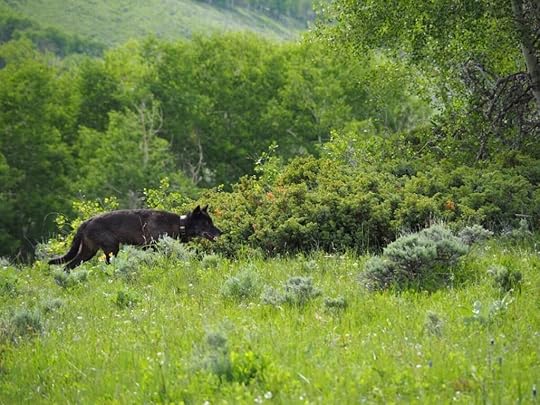 A Collared wolf moves through greenery. Photo courtesy Colorado Parks and Wildlife
A Collared wolf moves through greenery. Photo courtesy Colorado Parks and WildlifeFor the past 15 years, Luke Painter has been traveling to the northern range of Yellowstone National Park, where mountains rise and tributaries carve valleys of sage, willows and trees. This includes aspen, the beloved tree of fall that glows around this time of year as the season turns, catching the eye of Painter from his camper van that serves as his research hub.
His interest has gone far beyond aesthetics.
“I’ve just gotten really interested in this whole ecological process and how that’s developing,” said Painter, who teaches ecology and conservation at Oregon State University.
Conveniently, northern Yellowstone “has become a living laboratory for studying the interactions of aspen and other deciduous plants, large herbivores and large carnivores,” explains his latest paper in the journal Forest Ecology and Management.
The area is a living laboratory in the wake of wolf reintroduction, which began in 1995. And according to Painter’s latest work, the area demonstrates what might be a surprising link between the tree that is Colorado’s favorite and the animal that is its most controversial.
As Coloradans go leaf peeping in the weeks ahead, they probably won’t be thinking about wolves and the debate that has roiled the state since reintroduction started on the Western Slope in 2023. But aspen and wolves have indeed been on the mind of Painter as he’s continued surveys of predecessors.
His new paper reports a milestone: Sampled sites showed “the first documented recruitment of overstory aspen trees in northern Yellowstone since the 1940s.”
Painter emphasized a “mixed bag” overall; a third of the sites showed “saplings throughout” and another third “had patchy sapling recruitment.”
But “that’s all a big change from what we had in the past, which was nothing at all,” Painter said.
Whole swaths of aspen had been found to be chewed away by elk in the decades after wolves were extirpated. Elk are known to be prolific “browsers.” And without their prolific predator, their numbers were found to boom in areas where aspen struggled to regenerate as they naturally do, ensuring habitat for a vast array of plants and creatures that depend on the overstory.
This was part of the conversation leading up to Yellowstone’s wolf reintroduction in the ‘90s. Researchers have since explored the question: How would aspen and other important, browsed-upon species like willow respond?
“People have argued a lot about what factors have caused a decrease to the elk population, and it’s true, there are other factors involved,” Painter said. “But we would not be seeing the sustained reduction to elk numbers in the park without wolves. … They have made a big difference.”
But critics say the new research suggests too clear a link between the predator and aspen.
 Aspens show their golden colors Tuesday, Sept. 20, 2016, on Guanella Pass near Georgetown, Colo. (The Gazette, Christian Murdock)
Aspens show their golden colors Tuesday, Sept. 20, 2016, on Guanella Pass near Georgetown, Colo. (The Gazette, Christian Murdock)Media accounts have further oversimplified the connection, a statement from Colorado Parks and Wildlife suggested: “However, this popularized story has been called into question by recent research, which has shown that aspen recovery has been much slower than some initial studies indicated.”
That’s according to research from a paper published last year, also out of northern Yellowstone. Tom Hobbs, professor emeritus at Colorado State University, was the paper’s lead author.
Increased hunting around Yellowstone’s peripheries has played a major factor in elk numbers, he told The Gazette. “And at the same time wolves were recovering, so were cougars and grizzly bears. And it’s pretty well known cougars are actually more effective predators on elk than wolves are.”
Generally speaking, aspen are helped by a natural “food web” that includes wolves, Hobbs said. “But can we say in the relatively few decades that have passed since they were reintroduced (in Yellowstone) that they caused widespread ecosystem restoration? No, I don’t think so.”
Painter again emphasized the “mixed bag” of his study. Another 38% of sampled aspen sites “had few or no saplings,” the paper reads — the result of continued browsing and perhaps more trampling bison, Painter said.
Still, the paper sides with a contended trophic cascade — ecological restoration linked to a top predator. The debate continues in Yellowstone, as it does in Colorado, where the wolf controversy has more so focused on predated livestock and an altered way of life for ranchers.
As for aspen, it’s “certainly something CPW is interested in,” the agency said in response to questions from The Gazette. The statement referred to the trees providing habitat “for at least 29 species of greatest conservation need as identified in the State Wildlife Action Plan from 2015.”
However, overbrowsing “is not a widespread issue that is a concern of CPW,” the agency said, citing harvest numbers “helping hold ungulate herds to the population objectives established by our biologists.”
But in states without a native predator, overbrowsing has been a top concern for Paul Rogers. He’s a Utah State University professor who leads the Western Aspen Alliance, a multi-agency organization seeking to improve aspen ecosystems.
Rogers sees wolves as keeping elk moving in and out of young aspen stands — and “not just the two or three weeks of hunting season, but year-round,” he said. “That’s a problem in a lot of places, the sedentariness.”
Early into wolf reintroduction in Colorado, the question of impact is premature, Rogers said. “But I do think there’s a link that needs to be made between wolves, elk, aspen and biodiversity.”
Painter continues to explore the link; he was recently back in Yellowstone before the season turned. He was asked about the experience. “I hesitate to make a value statement,” he said, as any scientist hesitates to include emotion in the process.
And yet he recognized “the human effect” aspen has. “I want to cheer for them,” he said.
September 21, 2025
Broncos’ defense reacts to heartbreaking road loss to Chargers: ‘We’ve got to find ways to finish’
INGLEWOOD, Calif. — The visiting locker room at SoFi Stadium quietly cleared out Sunday afternoon as a Broncos defense found itself in disbelief.
Again.
They won the turnover battle with an interception and fumble recovery. They sacked Chargers quarterback Justin Herbert five times. But all that didn’t matter on their final drive of the game when Los Angeles kicker Cameron Dicker hit a 43-yard field goal to hand the Broncos a 23-20 defeat.
It was reminiscent of a Week 2 road loss to the Colts.
“We’ve got to just find ways to finish,” inside linebacker Alex Singleton said.
Their effort was summed up in another uncharacteristic mistake by cornerback Pat Surtain.
In the first quarter, defending a Chargers third-and-7, Herbert completed a pass to wide receiver Quentin Johnston about 10 yards downfield before getting met by Surtain. The reigning Defensive Player of the Year wrapped up Johnston but never brought him to the ground.
Johnston broke free. He ran away for a gain of 37 yards. It appeared Surtain expected his progress to be blown dead by the officials. But there wasn’t a whistle.
“Honestly, I’ve got to do a better job of finishing,” Surtain said. “I was frustrated that I gave up a catch. … I just sort of relaxed at the end. But I’ve got to finish and take him to the ground. That’s on me. I’ve got to know to bring him to the ground in that situation.”
Broncos team captains on defense expressed confidence despite a 1-2 record entering Monday Night Football against the Bengals (2-1) at home.
“It’s always a tough loss. Especially to a division opponent,” safety Talanoa Hufanga said. “But I started a season 4-4 and still made it to the NFC championship (with the 49ers). So, it’s not that we’re in a bad spot. … It’s close games, too. But there were mistakes that were made. We’ve got to go out and fix them.”
Surtain added: “I feel like everything is right in front of us. We control our own destiny. I believe in this team as a whole. I think we built a great team here. … We have a big game next week (on) Monday night. We’ve got to find a way to win that and then move onto the next. That’s our mindset. Correct what we’ve got to work on in the film room. Get better. That’s about it.”



